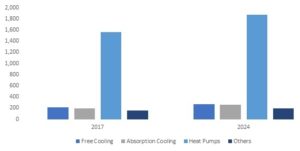Energy consumption to reach 13,000 TJ by 2024, research body says
The Europe District Cooling Market is set to grow from its current market value of more than USD 35 billion to over USD 40 billion by 2024, according to a new research report by Global Market Insights, Inc.
Acceleration in the demand for space cooling systems along with growing concerns about carbon emissions will drive the market size, the report said. Extreme climatic conditions across the region, including will stimulate product penetration, the report further said. For instance, in 2017, the number of annual cooling degree days (CDD) in Italy was 295, as compared with 200 in 2016, the report added.

Norway District Cooling Market Size, by Production technique, 2017 and 2024 (USD million)
According to Global Market Insights, ease of parity, economies of scale in the long run and high standards of operations and maintenance are some of the key features that will stimulate the Europe District Cooling market size. In addition, the high reliability and flexibility of systems with various production techniques will positively influence business growth, the report said.
The District Cooling market in Sweden is set to reach over 3,000 TJ by 2024, the report said. Increasing penetration of renewable energy technologies, owing to ambitious government targets toward sustainable technology adoption, will fuel business growth, the report also said. Geographical proximity to the Gulf Stream will further encourage product adoption across the nation, the report further said. In 2017, the government of Sweden, had planned to invest USD 103.5 million toward the development of the renewable energy sector by 2020, the report added.
The Commercial District Cooling market share is set to grow due to increasing emphasis on energy efficiency and sustainable building solutions, the report said. The increasing commercial floor space due to the flourishing service sector, along with ongoing investments in infrastructure development will stimulate industry growth, the report further said. According to Europe Real Estate the investments across commercial establishments were valued at USD 107.8 billon in the fourth quarter of 2016, the report added.
According to Global Market Insights, the heat pump District Cooling market is set to witness a growth of over two per cent by 2024. Increasing adoption of the product across Northern Europe, due to its ease of compatibility with conventional heating technology, will foster industry growth, the report said. These pumps are being widely used for cooling and heating purposes across residential and commercial establishments, where the technology uses waste heat to generate energy, thereby reducing the carbon emissions effectively when compared with its competitive counterparts, the report further said.
Technological advancement in product development and design, along with ongoing research and development activities, will propel product growth, the report said. Increasing government focus toward sustainable and energy-efficient establishments, along with stringent emission reduction targets will propel the District Cooling market in Europe, the report further said. The EU’s ‘Renewable Energy Directive’ has enforced standards toward the limitation and reduction of emissions caused by industries established across the region, the report added.
According to Global Market Insights, the District Cooling market in France will grow due to stringent government norms toward the adoption of energy-efficient technologies, along with accelerating population across the nation. In addition, the ongoing development of energy management systems, coupled with increasing investments toward innovative energy-efficiency solutions, will stimulate the DC grid network, the report said.
According to Global Market Insights, major industry players are focusing on product customisation and continuous research and development activities as a key strategy to sustain their presence across the region.
Copyright © 2006-2025 - CPI Industry. All rights reserved.